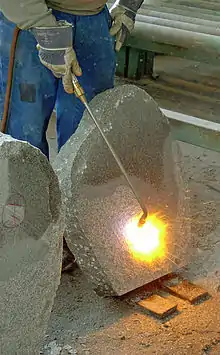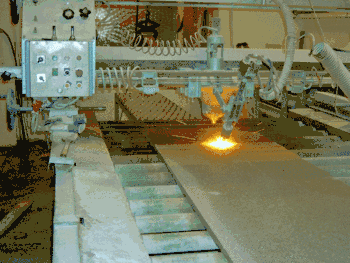Stone flaming
Stone flaming or thermaling is the application of high temperature to the surface of stone to make it look like natural weathering.[1][2] The sudden application of a torch to the surface of stone causes the surface layer to expand and flake off, exposing rough stone.

Flaming works well on granite, because granite is made up of minerals with differing heat expansion rates.
Process

After removing a rock from a quarry, the rock is sliced into multiple flat slabs using a diamond gang saw. The saw leaves flat surfaces with circular marks. Flaming is done by wetting, and then running an oxygen-acetylene or oxygen-propane torch over the surface. As seen in both photos, the torch is usually kept at a 45 degree angle to the stone.
Alternatives
Alternative techniques for creating a rough surface on sawed stone include:
- bush hammering
- sandblasting
- hydrofinishing
See also
References
- Chacon, Mark (1999). Architectural stone : fabrication, installation, and selection. New York: Wiley. ISBN 047124659X.
- "Granite and quartzite stone slabs processing by oxy-methane flaming" (PDF). European Commission.
External links
- Stone surfaces, photos of various surface treatments
- Palowy Stone, photos of stone flaming
- Understanding Flagstone: Sawcut, Thermaled, and Chiseled Edges
- Photos of hydrofinishing
